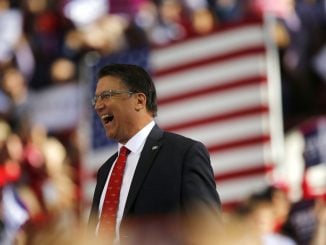RALEIGH While hundreds rallied Wednesday at Halifax Mall in downtown Raleigh in support of House Bill 13, members of the General Assembly continued to work on the issue regarding flexibility of K-3 class size in public schools.Last year’s state budget dictated that starting with the 2017-18 school year, kindergarten through third grade class sizes will be lowered to 19 to 21 students from the current 24, eliminating the class-size flexibility that was used by many schools to fund teachers of “specials” like physical education, art, foreign language and music.”What’s happened is this was a very good intended thought with the way that this was structured, but it created a ripple where it affected things that you didn’t necessarily realize on the surface it would affect,” Rep. Jeff Elmore (R-Wilkes) said.For Elmore, the ripple effect follows him back home, where he is an elementary school art teacher when he’s not in Raleigh with the legislature.”As a teacher serving down here, I get to see actually what’s happening in the school building,” he said.” And you see effects of this, and how the decision at the state level affects it, but then the decision at the local level affects it, too. And how that’s playing off one another.”He said in the mid-1990s the state collapsed those “specials” teachers’ funding into classroom teacher allotment.”When they did that, they created the flexibility with the funding, meaning we’re going to fund you at 1-to-18 ratio in kindergarten, but you can have as many as five additional kids,” Elmore said. “Where when you put three or five or however many you put in there, you do that in several classes, what that opens up is dollars to pay for your phys ed teacher, your art teacher, your second language teacher.”The rollback to smaller class sizes in last year’s budget intended to help schools reach the goal of having all of that state’s third-graders reading at grade level eliminated that flexibility.Further complicating the problem, Elmore said, is many schools are not following the original classroom size limits.”There are systems that have massive classes,” Elmore said. “They have just basically thumbed their nose up to the state law. We would see in the second grade classroom, for example and I won’t name the county that had four in one elementary school and it was 31 kids, 33 kids, 32 kids, 31 kids.”While the House has focused on the problem of classrooms with too many students, the Senate where H.B. 13 is currently stuck in rules committee after passing 114-0 in the House is looking at the related fiscal issues.Advocacy groups like the North Carolina Association of Educators are pushing for H.B. 13 to pass, warning parents that specials teachers could be laid off if flexibility isn’t returned to K-3 classroom size.That scenario would not only deprive children of classes like art and P.E., but would impact normal classroom teachers as well.”They utilize the special teachers not only to help basically teaching the whole child, but they’re used in the rotation of the school,” Elmore said. “Meaning the classroom teacher, in most places, they’re getting a 45-minute planning period. And how they get that planning period is through that class going to phys ed or going to the art class for the day.”Both the House and Senate are looking to solve the problem while also finding a way to hold accountable schools that aren’t in compliance of classroom size mandates.”So how do you create an accountability model that everybody doesn’t suffer, but it can pinpoint that 10 percent that is just outright not following the law,” Elmore said. “And that’s what we’re trying to figure out now: how do you balance the flexibility with proper accountability.”Elmore is optimistic the General Assembly will find a solution, which is needed soon due to year-round schools beginning their 2017-18 years in the coming months.”I feel like there is a solution that we will come up with to help with it,” he said.
Related Articles

Article
Trump to nominate ex-congressman to lead international aid agency
WASHINGTON, May 10 (Reuters) – President Donald Trump will nominate former congressman Mark Green to head the U.S. Agency for International Development, the White House said in a statement on Wednesday. Green is a former […]

Article
Trump revokes Washington Posts campaign press credentials
WASHINGTON – Republican Donald Trump said on Monday he will no longer issue press credentials to the Washington Post, stopping the publication from gaining access to press areas at his presidential campaign events. His next […]

Article
McCrory looks toward the future
CHARLOTTE At Tuesday’s Rotary Club meeting in Charlotte, former Gov. Pat McCrory was honored with the Excellence in Leadership Award. The Rotarian honor recognizes excellence in industry and public service leaders with high ethical […]
